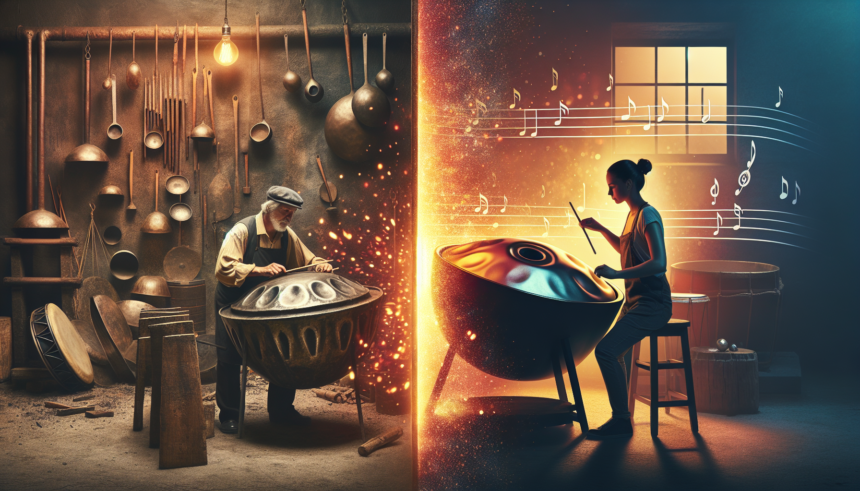The world of music is a captivating tapestry woven with sounds from diverse cultures and epochs. Among the myriad of musical instruments that have etched their presence into the hearts of millions, two stand out not only because of their unique sounds but also due to their compelling histories: the steelpan and the hang drum. While both instruments occupy distinct corners of the musical landscape, their origin stories and evolutions are tales of innovation, resilience, and serendipity.
The Steelpan: Born from Necessity and Creativity
The steelpan, which is often referred to as the steel drum, hails from the Caribbean island of Trinidad. The instrument’s inception is closely tied to the island’s colonial history and the socio-economic circumstances that shaped its communities. The steelpan emerged out of necessity during the early 20th century as Trinidadians sought means of expression amidst societal constraints.
The origins of the steelpan can be traced to the traditional African drum and bamboo percussion ensembles known as Tamboo Bamboo. However, colonial authorities frequently banned these traditional forms of music, viewing them as a threat to social order. In response, local musicians turned to discarded oil drums, which were abundant on the island due to burgeoning oil refineries.
The craftsmen initially started with biscuit tins, dustbins, and other metallic containers, experimenting with different materials to produce desired sounds. By hammering and experimenting with these materials, they discovered that varying the shape and size of the dents could produce unique pitches. Over time, oil drums became the preferred choice due to their robust structure and resonance.
The steelpan’s evolution was influenced heavily by pioneering innovators such as Winston “Spree” Simon and Ellie Mannette. With relentless experimentation, they refined the instrument’s design, enhancing its tonal precision and harmonic richness. By the mid-20th century, the steelpan had grown into a sophisticated musical instrument capable of producing intricate melodies and harmonies.
Its recognition surged internationally with the rise of steelbands like the Trinidad All Steel Percussion Orchestra (TASPO), which showcased the instrument on global stages, demonstrating its versatility across genres ranging from calypso to classical music. Today, the steelpan is not only a symbol of Trinidadian culture and identity but also a testament to human ingenuity and the power of music to transcend boundaries.
The Hang Drum: A Swiss Innovation with Ancient Inspirations
In contrast to the steelpan’s community-driven evolution, the hang drum is a relatively modern creation that blends ancient musical traditions with innovative engineering. The hang drum was developed in Switzerland by Felix Rohner and Sabina Schärer of PANArt, and it made its debut in 2000. The instrument’s name, “hang,” derives from the Bernese German word for “hand,” reflecting its mode of play.
While the hang drum is often compared to the steelpan due to its metal construction and percussive nature, its inspiration draws from a broad spectrum of traditional instruments, including the Trinidadian steelpan, the Indonesian gamelan, the Indian ghatam, and the African udu. Rohner and Schärer aimed to create an instrument that combined these diverse influences into a single, harmonious entity.
Crafted from two hemispherical shells of nitrided steel, the hang drum resembles a UFO or a wok turned upside down. The top surface, known as the “Ding,” features a central note surrounded by a series of tone fields, each producing a distinct pitch. The bottom shell, called the “Gu,” has a resonating hole that allows for overtones and complex harmonic interactions.
Unlike the steelpan, whose tones are struck with mallets, the hang drum is played entirely with the hands. This tactile interaction allows players to explore subtle nuances in timbre and dynamics, producing an ethereal, meditative soundscape. The instrument’s unique timbral quality has garnered a devoted following among musicians and enthusiasts worldwide, captivating listeners with its enchanting melodies and rich harmonic overtones.
PANArt initially produced the hang drum in limited quantities, emphasizing artisanal craftsmanship and the instrument’s unique acoustic properties. However, the instrument’s popularity soared, leading to a proliferation of similar handpans produced by other manufacturers around the world.
Comparative Analysis: The Steelpan and the Hang Drum
Although the steelpan and hang drum share a common heritage in metal percussive instruments, they represent different aspects of musical evolution. The steelpan’s journey from marginalized communities to global stages underscores the resilience and creativity inherent in human societies. In contrast, the hang drum’s creation exemplifies the fusion of traditional sonic elements with contemporary innovation.
Both instruments have had significant cultural impacts. The steelpan is deeply embedded in Caribbean culture, representing a symbol of national pride and identity. Steelbands have become a staple in Trinidad’s Carnival, and the instrument has permeated diverse musical genres, contributing to jazz, symphonic works, and popular music.
The hang drum, while not tied to a singular cultural context, has influenced various musical landscapes by fostering a sense of inclusivity and meditative exploration. Its calming, resonant tones have found their way into ambient music, yoga practices, and therapeutic settings, promoting relaxation and mindfulness.
Moreover, both instruments demonstrate the transformative power of music as a universal language. The steelpan’s journey from discarded oil drums to concert halls and the hang drum’s rapid ascent to global renown highlight music’s ability to foster connections and deepen our understanding of human creativity.
Conclusion
From the streets of Trinidad to Swiss workshops, the stories of the steelpan and the hang drum offer rich narratives about the evolution of musical expression. While the steelpan emerged from a context of oppression and ingenuity, the hang drum was born out of a desire to create a new sonic experience by blending ancient traditions with modern craftsmanship.
Both instruments have significantly impacted the global musical landscape, transcending their humble beginnings or niche origins to find a place in diverse musical genres and cultural contexts. Their histories remind us of music’s resilient nature and its profound power to unite, heal, and inspire.
FAQs
- What is the steelpan?
The steelpan, also known as the steel drum, is a percussion instrument originating from Trinidad. It is made from an oil drum and consists of a concave metal surface with several tuned pitches, each created by hammering convex shapes into the drum’s surface.
- Who invented the hang drum?
The hang drum was invented by Felix Rohner and Sabina Schärer of PANArt in Switzerland. It was introduced in 2000 and combines elements from various traditional instruments around the world.
- How is the hang drum different from the steelpan?
While both instruments are made of metal and produce melodic tones, the steelpan is typically played with mallets and has its roots in Caribbean culture, whereas the hang drum is played with the hands and blends influences from multiple musical traditions, resulting in a more ethereal and meditative sound.
- Can the steelpan and hang drum be used in different music genres?
Yes, both instruments are versatile and have been used in various musical genres. The steelpan is prominent in calypso, soca, and Caribbean music, but it has also been featured in jazz, classical, and popular music. The hang drum is frequently used in ambient, world music, and therapeutic settings.
- How has the steelpan influenced global music?
The steelpan has significantly influenced global music by demonstrating the potential of repurposed materials to create sophisticated instruments. It has introduced distinctive Caribbean sounds to the world and inspired composers and musicians across different genres to integrate its unique tones.





